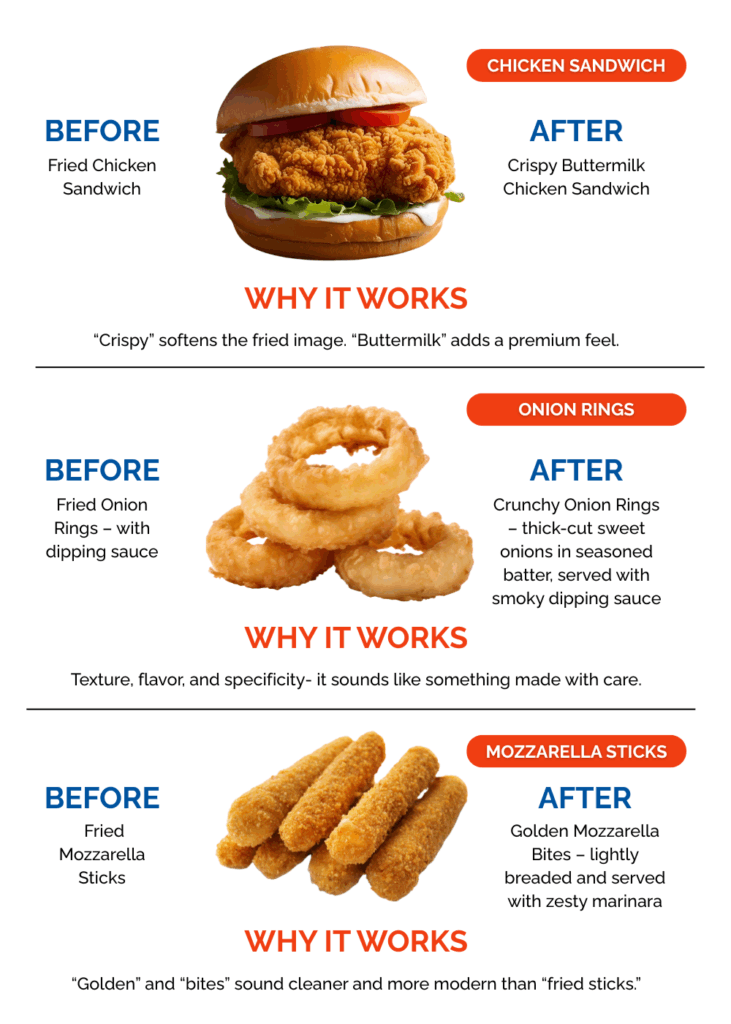Crispy Sells: Why Menu Language Matters More Than Ever

What sounds more appetizing: a fried chicken sandwich or a crispy buttermilk chicken sandwich? For today’s health-conscious diners, the menu language can make all the difference.
Fried food isn’t going anywhere, but guests want to feel better about what they’re ordering. With a few clever menu language tweaks, operators can keep the crave factor high while giving menu items a lighter, more premium feel without changing the food itself.
The Psychology of Menu Language
When guests scan a menu, their decisions happen quickly. One word can influence what they order, how they perceive the dish, and even how satisfied they feel afterward.
Studies on menu engineering show that descriptive terms like “crispy,” “golden,” or “hand-breaded” can increase sales by up to 27 percent. These words give cues about texture, freshness, and quality. “Fried,” while accurate, often triggers thoughts of grease and heaviness. On the other hand, “crispy” sounds clean, light, and satisfying.
That shift in perception is key. Diners still want comfort food, but they want it to sound intentional and well-prepared. Swapping in language that highlights texture and craftsmanship helps operators meet that expectation.
How Words Shape Perceptions of Health and Quality
Health-focused diners aren’t skipping fried foods entirely. They’re just more mindful. The way menu items are described can either invite them in or push them away.
“Crispy” feels less indulgent than “fried.” It suggests texture without excess. Add words like “lightly breaded,” “house-seasoned,” or “oven-finished,” and a dish immediately sounds more balanced and chef-driven.
Guests also associate detailed descriptions with quality. When a menu calls out elements like “buttermilk marinade” or “thick-cut sweet onions,” it sends the message that thought went into the food. These subtle cues help justify the choice and often the price.
Menu Makeover: Real-World Rewrites

Here are a few examples that show how minor edits can increase appeal without altering the dish.
Chicken Sandwich
Before: Fried Chicken Sandwich
After: Crispy Buttermilk Chicken Sandwich
Why it Works: “Crispy” softens the fried image. “Buttermilk” adds a premium feel.
Onion Rings
Before: Fried Onion Rings – with dipping sauce
After: Crunchy Onion Rings – thick-cut sweet onions in seasoned batter, served with smoky dipping sauce
Why it Works: Texture, flavor, and specificity- it sounds like something made with care.
Mozzarella Sticks
Before: Fried Mozzarella Sticks
After: Golden Mozzarella Bites – lightly breaded and served with zesty marinara
Why it Works: “Golden” and “bites” sound cleaner and more modern than “fried sticks.”
The key is accuracy. These aren’t exaggerated claims. They’re strategic choices that reflect what’s already happening in the kitchen, just told in a way that resonates with today’s guest.
The Tech Behind the Texture
Of course, you can’t call it crispy if it isn’t. That’s where your equipment comes in.
Pitco fryers deliver consistent results. From maintaining oil temperature to recovering quickly during busy shifts, our fryers help operators hit the texture target every time. Whether it’s chicken, seafood, or vegetables, the right fryer ensures food comes out crisp, golden, and ready to back up every menu claim.
Consistency isn’t just about efficiency. It’s what gives operators the confidence to call their food crispy and know it delivers on the promise.
Topics
- Foods & Trends (91)
- Fryers (87)
- Oil (57)
- Fried Food (52)
- Filtration (32)
- See All Topics

